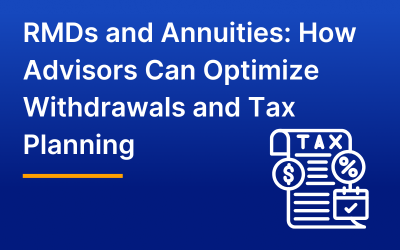RMDs and Annuities: How Advisors Can Optimize Withdrawals and Tax Planning
Retirees face many financial decisions, but few are as important — and often as confusing — as managing annuity Required Minimum Distributions (RMDs). Financial advisors play a key role here, ensuring that clients not only meet their RMD obligations but do so in a tax-efficient manner. Annuities add another layer of complexity to RMD planning, so it’s necessary for advisors to have the right strategies and tools in place.
One such tool is Income Lab’s Annuity Planning software, which simplifies annuity RMD management and helps advisors model different withdrawal scenarios and optimize tax outcomes.
Utilizing tools like this one means advisors can better serve their clients while ensuring compliance with IRS regulations.
Understanding How RMDs Apply to Annuities
Annuity RMDs are mandatory withdrawals that individuals must take from their qualified retirement accounts, such as IRAs and 401(k)s, once they reach a certain age — currently 73. These withdrawals are subject to taxation and must be carefully planned to avoid unnecessary tax burdens.
Annuities, depending on whether they are qualified or non-qualified, impact RMD calculations differently:
- Qualified annuities, which are funded with pre-tax dollars, are subject to annuity RMD rules, meaning that distributions must begin at the required age.
- Non-qualified annuities, which are funded with after-tax dollars, are not subject to RMDs, though their tax treatment depends on how the funds are withdrawn.
Different types of annuities, including fixed, variable, and deferred, carry unique considerations when it comes to RMDs, requiring careful assessment to ensure withdrawals comply with IRS annuity RMD rules.
One common misconception is that annuities allow retirees to skip RMDs, which is not the case. Advisors must ensure clients understand their obligations and how annuities fit into their overall annuity RMD strategy.
The Biggest RMD Mistakes Advisors Must Help Clients Avoid
Many retirees make costly annuity RMD mistakes, including missing an RMD deadline, which results in a hefty IRS penalty of 25% on the missed amount. Others assume annuity payouts automatically satisfy annuity RMD requirements when in reality, this depends on the annuity type and structure.
Some clients over-withdraw, creating unnecessary tax burdens that could have been minimized with proper planning, while others fail to coordinate withdrawals across multiple accounts, leading to inefficient distributions and missed opportunities to optimize tax outcomes.
Not using technology to project future RMDs is another common mistake. Advisors who proactively address these pitfalls can save their clients from costly errors and help them preserve their retirement assets.
Tax-Efficient Strategies for Managing RMDs from Annuities
Smart tax planning is important when managing RMDs from annuities. Advisors can guide clients toward tax-efficient strategies such as Roth conversions, which allow for the transfer of funds from traditional retirement accounts to Roth IRAs before reaching RMD age, lowering future taxable distributions.
Qualified Longevity Annuity Contracts (QLACs) can help defer a portion of RMDs until later years, which reduces taxable income in the earlier retirement years. Tax bracket management is another effective approach and ensures that withdrawals are spread strategically to prevent clients from moving into higher tax brackets.
The timing of annuity RMD payouts is also important. Aligning annuity distributions with required withdrawals helps advisors create a tax-efficient income stream for their clients.
Using Income Lab’s Annuity Planning software, advisors can model multiple tax scenarios, allowing them to identify the most efficient withdrawal strategies for their clients.
The Role of Technology in RMD Planning: Why Advisors Need Income Lab
Manual RMD and annuities calculations are inefficient and can lead to costly errors. Advisors need software that allows them to test different tax-efficient withdrawal strategies in real-time, like Income Lab’s Annuity Planning software. It’s designed specifically for financial professionals looking to optimize RMD and annuities strategies and provides real-time visualization of tax-efficient withdrawal scenarios.
The software projects RMD obligations across different accounts and annuities, ensuring accurate and compliant planning. Additionally, it identifies Roth conversion opportunities and other tax-minimization tactics.
Final Thoughts: Helping Clients Stay Compliant & Tax-Efficient
Managing RMDs and annuities can be tricky, but a proactive approach makes all the difference. Financial advisors can help clients stay compliant while making smart decisions to minimize taxes and stretch their retirement income further.
With the right tax-efficient strategies and the support of Income Lab’s advanced planning software, advisors can simplify the process and give their clients greater confidence in their financial future.
Want to see how it works? Schedule a demo of Income Lab’s Annuity Planning software today!



